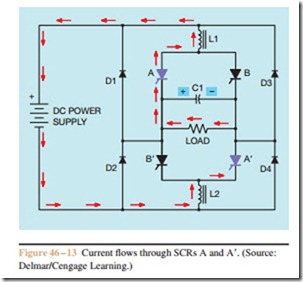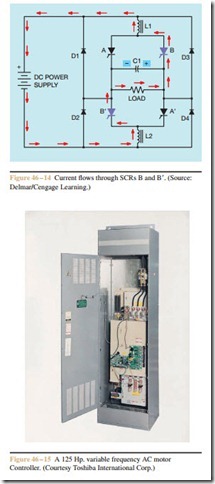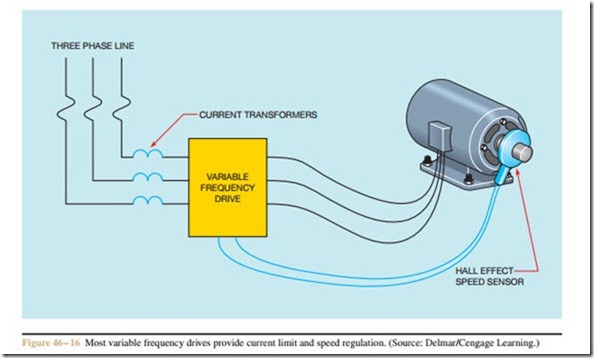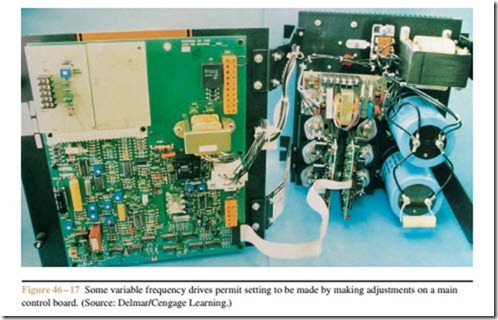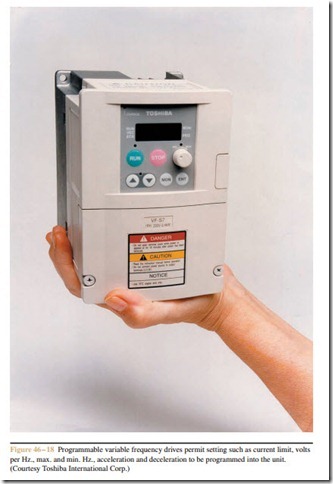Variable Frequency Drives Using SCRs and GTOs
Variable frequency drives intended to control motors over 500 horsepower generally use SCRs or GTOs (gate turn off device). GTOs are similar to SCRs except that conduction through the GTO can be stopped by ap- plying a negative voltage—negative with respect to the cathode—to the gate. SCRs and GTOs are thyristors and have the ability to handle a greater amount of cur- rent than transistors. Thyristors are solid-state devices that exhibit only two states of operation: completely turned on or completely turned off. An example of a single-phase circuit used to convert DC voltage to AC voltage with SCRs is shown in Figure 46 – 12. In this circuit, the SCRs are connected to a phase shift unit that controls the sequence and rate at which the SCRs are gated on. The circuit is constructed so that SCRs A and A’ are gated on at the same time and SCRs B and B’ are gated on at the same time. Inductors L1 and L2 are used for filtering and wave shaping. Diodes D1 through D4 are clamping diodes and are used to prevent the output voltage from becoming excessive. Capacitor C1 is used to turn one set of SCRs off when the other set is gated on. This capacitor must be a true AC capacitor because it will be charged to the alternate polarity each half cy- cle. In a converter intended to handle large amounts of power, capacitor C1 will be a bank of capacitors. To understand the operation of the circuit, assume that SCRs
A and A’ are gated on at the same time. Current will flow through the circuit as shown in Figure 46 – 13. Notice the direction of current flow through the load, and that ca- pacitor C1 has been charged to the polarity shown. When an SCR is gated on, it can only be turned off by permitting the current flow through the anode-cathode section to drop below a certain level, called the holding current level. As long as the current continues to flow through the anode-cathode, the SCR will not turn off.
Now assume that SCRs B and B’ are turned on. Because SCRs A and A’ are still turned on, two current paths now exist through the circuit. The positive charge on capacitor C1, however, causes the negative electrons to see an easier path. The current will rush to charge the capacitor to the opposite polarity, stopping the current flowing through SCRs A and A’, permitting them to turn off. The current now flows through SCRs B and B’ and charges the capacitor to the opposite polarity (Figure 46 – 14). Notice that the current now flows through the load in the opposite direction, which produces alternating current across the load.
To produce the next half cycle of AC current, SCRs A and A’ are gated on again. The positively charged side of the capacitor will now cause the current to stop flowing through SCRs B and B’, permitting them to turn off. The current again flows through the load in the direction indicated in Figure 46 – 13. The frequency of the circuit is determined by the rate at which the SCRs are gated on. A variable frequency drive rated at 125 horsepower is shown in Figure 46 – 15.
Features of Variable Frequency Control
Although the primary purpose of a variable frequency drive is to provide speed control for an AC motor, most drives provide functions that other types of controls do not. Many variable frequency drives can provide the low speed torque characteristic that is so desirable in DC motors. It is this feature that permits AC squirrel cage motors to replace DC motors for many applications.
Many variable frequency drives also provide cur- rent limit and automatic speed regulation for the motor. Current limit is generally accomplished by connecting current transformers to the input of the drive and sensing the increase in current as load is added. Speed regulation is accomplished by sensing the speed of the motor and feeding this information back to the drive (Figure 46 – 16).
Another feature of variable frequency drives is acceleration and deceleration control, sometimes called ramping. Ramping is used to accelerate or decelerate a motor over some period of time. Ramping permits the motor to bring the load up to speed slowly as opposed to simply connecting the motor directly to the line. Even if the speed control is set in the maximum position when the start button is pressed, ramping forces the motor to accelerate the load from zero to its maxi- mum RPM over several seconds. This feature can be a real advantage for some types of loads, especially gear drive loads. In some controllers, the amount of acceleration and deceleration time can be adjusted by setting potentiometers on the main control board (Figure 46 – 17). Other controllers are completely digitally controlled and the acceleration and deceleration times are programmed into the computer memory.
Some other adjustments that can usually be set by changing potentiometers or programming the unit are as follows:
Current Limit: This control sets the maximum amount of current the drive is permitted to deliver to the motor.
Volts per Hertz: This sets the ratio by which the volt- age increases as frequency increases or decreases as frequency decreases.
Maximum Hertz: This control sets the maximum speed of the motor. Most motors are intended to operate between 0 and 60 hertz, but some drives permit the output frequency to be set above 60 hertz,
which would permit the motor to operate at higher than normal speed. The maximum hertz control can also be set to limit the output frequency to a value less than 60 hertz, which would limit the motor speed to a value less than normal.
Minimum Hertz: This sets the minimum speed the motor is permitted to run.
Some variable frequency drives permit adjustment of current limit, maximum and minimum speed, ramping time, and so on, by adjustment of trim resistors located on the main control board. Other drives employ a microprocessor as the controller. The values of current limit, speed, ramping time, and so on, for these drives are programmed into the unit and are much easier to make and are generally more accurate than adjusting trim resistors. A programmable variable frequency drive is shown in Figure 46 – 18.
Review Questions
1. What is the synchronous speed of a six-pole mo- tor operated with an applied voltage of 20 hertz?
2. Why is it necessary to reduce the voltage to a mo- tor when the frequency is reduced?
3. If an alternator is used to provide variable fre- quency, how is the output voltage of the alternator controlled?
4. What solid-state device is generally used to pro- duce variable frequency in drives designed to con- trol motors up to 500 horsepower?
5. Why are SCRs used to construct a bridge rectifier in many solid-state variable frequency drives?
6. What is the main disadvantage of using SCRs in a variable frequency drive?
7. How are junction transistors driven into satura- tion, and what is the advantage of driving a tran- sistor into saturation?
8. What is the disadvantage of driving a junction transistor into saturation?
9. What is the advantage of an IGBT over a junction transistor?
10. In variable frequency drives that employ IGBTs, how is the output voltage to the motor controlled?
11. What type of motor is generally used with IGBT drives?
12. What is the primary difference between a GTO and an SCR?
13. What is a thyristor?
14. After an SCR has been turned on, what must be done to permit it to turn off again?
15. What is meant by “ramping” and why is it used?
